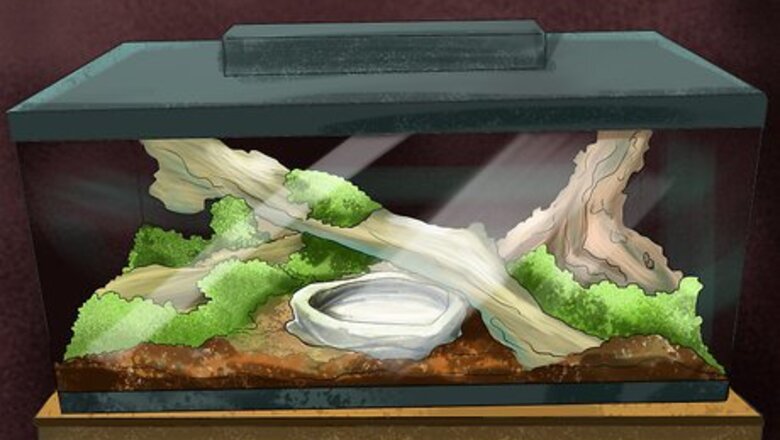
views
Providing Housing
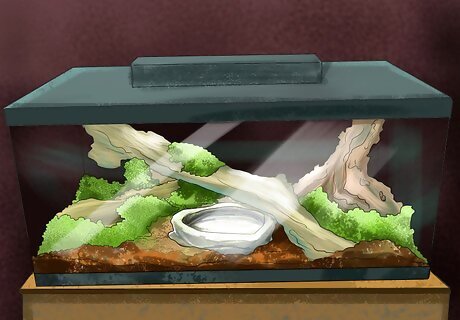
Obtain an enclosure large enough for the skink. A good lizard tank will provide enough space for the skink to roam about relatively freely. To keep it safe from cats and other house pets, place a mesh screen over the skink's tank. Ensure it is as large as possible. You can buy a terrarium fit for a five-lined skink at most local pet stores. Weather permitting, your skink can be housed safely outside. Ensure you have a mesh screen on the top of the cage to prevent potential predators from attacking your skink.
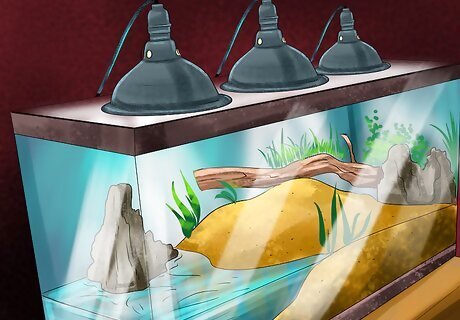
Provide a gradient of heat. Measure the amount of heat at different points in the tank from one end to the other in five centimeter intervals. In other words, take a temperature reading at one end, then move down the length of the cage five centimeters, and take another temperature reading. Heat can easily be applied to one end of the cage by dangling an incandescent light over one end of the tank. The temperature for the hottest part of the tank, just below the light, should be 97 degrees Fahrenheit. Temperatures should never drop below 70 degrees Fahrenheit. You could place a heat mat below or on one side of the tank for added heat.
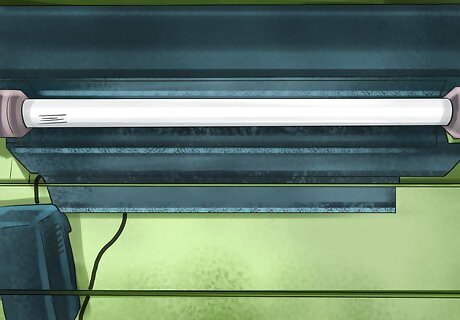
Provide ultraviolet light. Lizards need two kinds of ultraviolet light (UV-A and UV-B) to see properly and produce vitamin D3, which strengthens bones. Obtain an ultraviolet light from your local pet store to ensure your skink is getting the proper amount of UV light. Do not install UV-B lights not designed for use in pet enclosures. Other sources of ultraviolet light -- such as tanning salon lights, tubes made for human phototherapy, and mercury vapor lights -- produce it at levels unsafe for pets as well as humans. These lights might also produce dangerous UV-C light which causes cancer and immune suppression. There is little data available delimiting how much ultraviolet light a skink needs. Consult your veterinarian as to what an appropriate level of ultraviolet light for your five-lined skink might be.
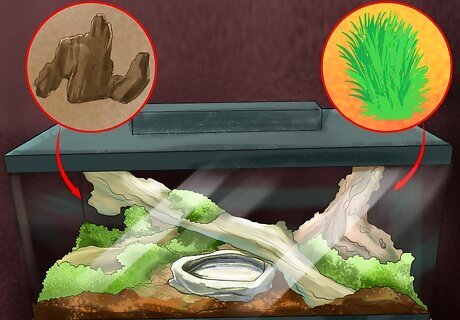
Decorate the tank. The natural habitat of the five-lined skink is a moist wooded or partially wooded area. They enjoy habitats consisting of or including bark, rocky outcrops, logs, and stumps. To recreate this habitat, you will need to obtain a woodland terrarium. This type of enclosure consists of a substrate composed of sphagnum moss, potting soil, loam, small gravel, or reptile carpet. Pepper the tank with plants, rocks, and bits of tree bark. Plants can be set in small pots or planted directly into the earth if using potting soil. Terrariums for lizards are easily obtained at most local pet stores.

Quarantine new skinks. If introducing a new skink into a tank already populated by other lizards, place them in a quarantine tank. A quarantine tank is a tank separate from., but identical to, the tank which already contains other lizards. This will prevent the spread of infectious diseases (if there are any) from the new lizard into your primary lizard population. Male skinks should not be housed with other males; they will fight and possibly harm each other. You can identify males in a number of ways: Males do not lay eggs. Females lay eggs in soil or rotten wood and tend to them until they hatch about two months later. Male adult five-lined skinks may have bright orange jaws during the period in which it breeds. Males are generally a bit larger than the females. Females retain a blue-gray tail into adulthood; males acquire brown tails as they age.
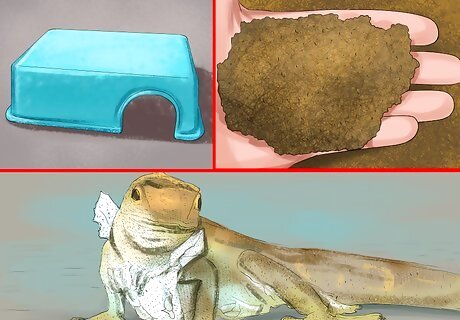
Provide a shed box. A shed box will allow the skink to shed its skin as it grows and ages. Shedding is a natural behavior for lizards. A shed box is a small “house” for the skink (known as a hide box) containing sphagnum moss. Taking refuge in the shed box will ease the shedding process for the skink. Hide boxes are available at most pet stores. Once a skink starts shedding, it should take no more than three weeks for the skin to come off completely. If your skink sheds infrequently (once or twice each year), consult a veterinarian.
Handling Your Skink
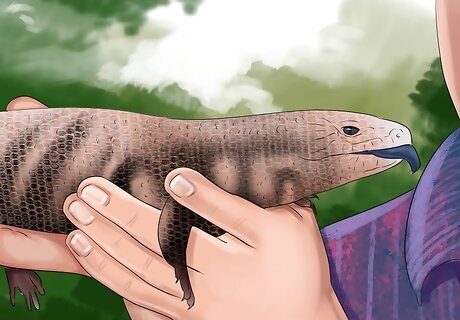
Be gentle. Always handle your lizard gently. Do not squeeze or drop him. Ensure you place him down as soon as possible after lifting him, as prolonged or over-handling is the most common cause of lizard death. Do not pull your skink's tail. Young five-lined skinks have blue tails, used in the wild to attract predators away from its body. If pulled, the tail will detach, allowing the skink to escape. The tail will later regrow, but should not be pulled off, as this will cause the skink undue stress.
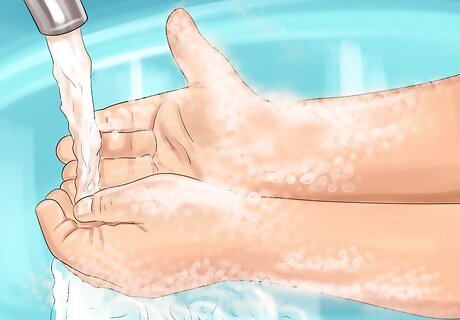
Wash your hands before and after handling. Many reptiles and amphibians carry Salmonella germs on them even if they appear healthy and clean. Salmonella germs can be spread through contact with other skinks or through their droppings. Before handling the skink Wet your hands with clean water, then turn off the tap. Apply soap and lather your hands by rubbing them together for about twenty seconds. Be sure to scrub the areas between your fingers, under your nails, and on the backs of your hands. Turn the tap back on and rinse the soap away. Do not bathe your skink or wash its tank in the same tub or sink you use to bathe or wash dishes in, respectively.
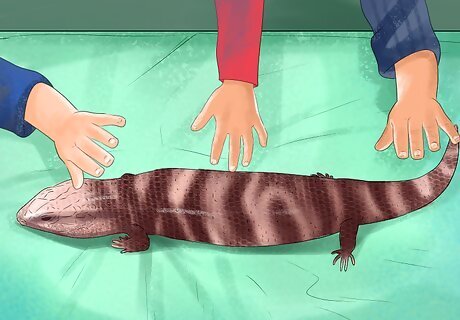
Do not let children handle the skink. This is a good rule for both the children and the skink. Children have weaker immune systems than adults and are more prone to contract Salmonella from the skink than adults, even when they've taken the necessary sanitary precautions. Furthermore, they might not understand how to hold the skink gently enough not to hurt him, or may become surprised by the skink and drop him. Do not let children play or run near the skink's cage; they may run into it, knock it over, or otherwise get into mischief with your pet skink.
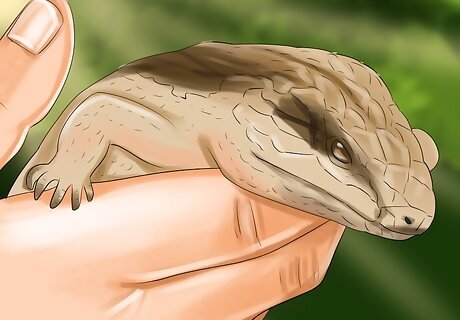
Pick the skink up with one hand. Form your hand into a “C” shape. Lower your hand slowly into the skink's tank. Tuck your thumb under the left side of his flank and your other four fingers beneath the right side of his flank. Close your hand slowly until the skink's flesh is pressed against your along the entire length of the “C.” Do not squeeze too tightly or apply pressure. Avoid holding the skink for prolonged periods; it will become ornery and try to wriggle free, creating the potential you will drop him.
Feeding the Skink
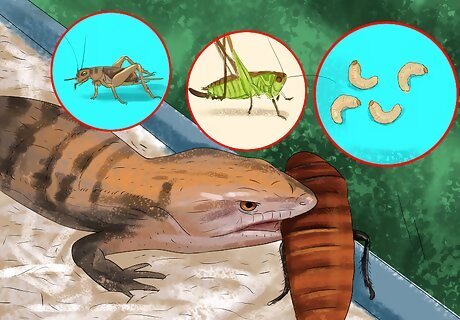
Obtain food the skink likes. Skinks are active foragers that feed on insects such as crickets, flies, grasshoppers, grubs, beetles, and ants. They can also eat spiders. They might also be able to consume larger prey such as smaller lizards, frogs, and newborn mice. Only provide food for your skink sourced from pet stores. Vary your skink's diet. Never feed it just one item for a long period.
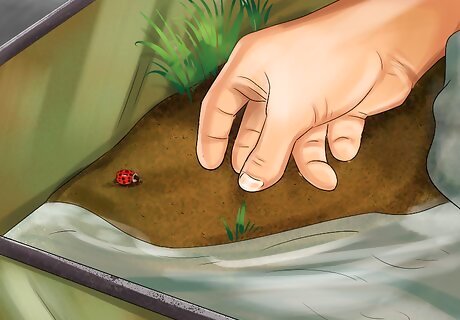
Do not leave live prey in the tank for a long period. Predatory lizards like skinks are sight feeders. If they become accustomed to seeing live prey in the cage, they may become desensitized to the presence of movement and lose their predatory instinct. Live bugs left overnight are fine, but do not keep them in the cage for longer than that. The amount of food your skink needs will vary depending on age and size, but a general rule is that it should be allowed to consume as many crickets (or whatever bug it prefers) as it wants for a period of three to five minutes.
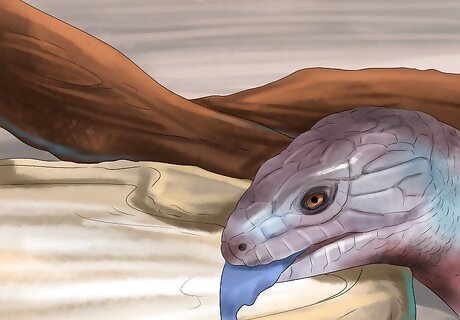
Provide an adequate amount of water. Clean, filtered water must be provided for the skink on a daily basis. Use a heavy water bowl made of porcelain so as to eliminate the possibility of the skink spilling the water. Water bowls for lizards are available at local pet stores. In addition to drinking water, ambient water should be applied to the entire cage. Fill a spray bottle with water and mist the cage every 4-5 days. The substrate should be damp to the touch, but free of puddles.
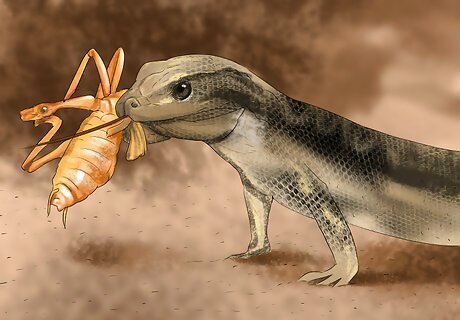
Only use high-quality food. Never feed skinks wild insects. They may carry diseases. Ensure the bugs you feed your skink are healthy and themselves well-fed before moving up the food chain. Further, when feeding your skink larger bugs, ensure that they have recently molted. Insects with hard exoskeletons may be difficult for your skink to digest. Do not feed lightning bugs to your skink; they are poisonous to skinks.
Preventing and Treating Illnesses
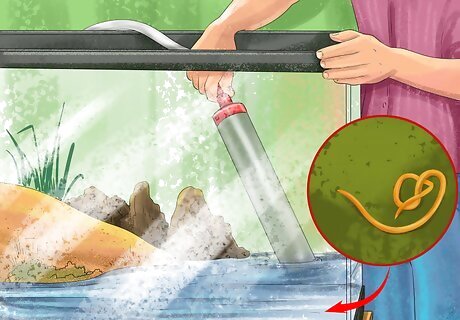
Keep the skink's environment clean and well-maintained. Do not, for example, leave dead bugs lying about your skink's tank. Change your skink's water regularly. Failing to keep the environment clean can lead to multiple ailments. Captive skinks have a higher level of stress than those in the wild, leaving them at greater risk for parasites. Parasites which target skinks include: Hookworms, which may cause mineral deposits in the skink's gut Stomach worms, which cause stomach ulcers Ascarids, which also cause mineral deposits in the intestines and may cause vomiting Give your skink regular veterinary checkups to ensure it is free of parasites.
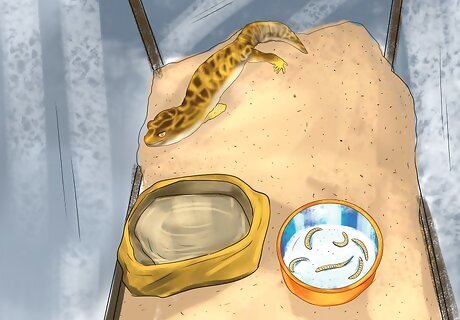
Ensure your skink is eating enough. If you observe a loss of appetite, vomiting, or marked weight loss in your skink, it may be suffering from cryptosporidiosis. This infectious condition is caused by a certain species of protozoa. Veterinarians are specially trained to detect it by feeling for a mass in the skink's stomach, and can take X-rays to check for internal changes which may indicate cryptosporidiosis. Ensure also your skink gets enough to drink. Dehydration can lower the skink's immune system and can even cause death directly.
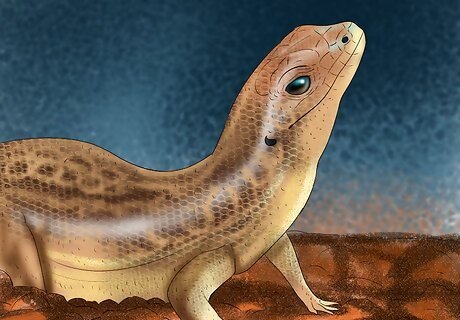
Look out for star-gazing. Star-gazing is a neurologic disorder caused by a retrovirus, and leads to an inability to move normally. It is also easily identified by the behavior from which it derives its name: a star-gazing skink will have its head craned straight up and become insensitive to stimuli. Star-gazing is a result of any number of problems -- infections, heat damage, or trauma are all potential causes. Get your skink to a vet if you observe this condition.
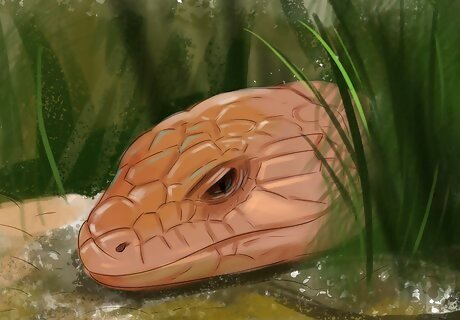
Observe your skink's breathing. If your skink breathes with its mouth open, has discharge running from its nose or dried pus around its mouth, or is visibly heaving with each breath, consult a veterinarian immediately. Possible causes of such behavior include pneumonia or paramyxovirus. Curing lung ailments depends on the specific condition. A vitamin A deficiency may be one cause. This can be remedied by providing skinks a healthy diet with bugs dusted with nutritional powder. Another solution could be to adjust environmental conditions. Turning the temperature down and scraping off the top layer of the terrarium's soil with a small shovel can help keep it clean and comfortable for your skink.
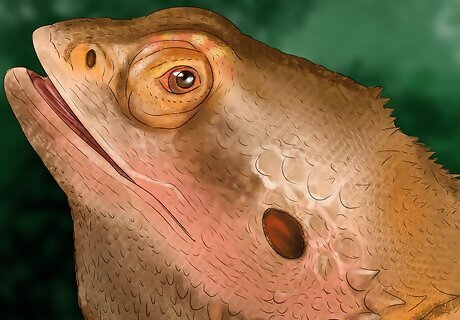
Look for eye or ear problems. If the tissue around your skink's eyes appears irritated, discolored, or inflamed, it may have contracted conjunctivitis or have abscesses. Excessive exposure to UV light can cause conjunctivitis. Conjunctivitis in skinks manifests as a white layer over the eye. Removing or toning down the UV light will correct the problem, though more severe cases might requires topical antibiotics. Ear infections are rare in skinks, but are easily prevented with an adequate amount of vitamin A. Ensure your skink receives an adequate amount of vitamin A and other nutrients by investing in a commercially available supplement powder. Dusting the insects you feed the skink with this powder before feeding will give the skink necessary nutrients.
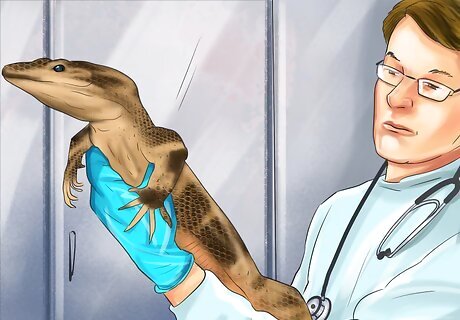
Get a vet. A vet knowledgeable about five-lined skinks can be difficult to locate. Contact your local herpetology societies for referrals to a vet who can help you. You might also try to locate a vet through the Association of Reptilian and Amphibian Veterinarians. Check their vet database at https://members.arav.org/search/custom.asp?id=3661. If you are ever worried about your skink's health, schedule an appointment with your vet to address your concerns immediately. The longer you wait, the worse the condition might become.



















Comments
0 comment